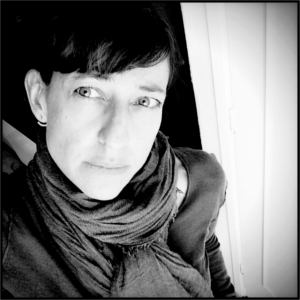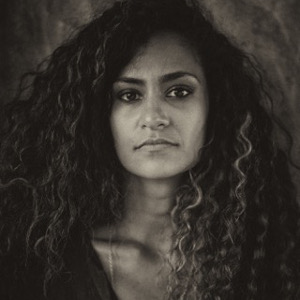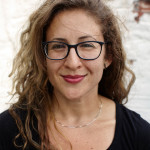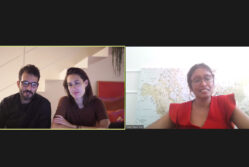
Adriana Zehbrauskas (self portrait)

Kirsten Luce

Malin Fezehai | Photo: Delphine Diallo

Glenna Gordon
Please join the OPC and Columbia Journalism School for a panel discussion with 4 female photojournalists who are independently pursuing in-depth documentary work. We will discuss how they find stories, seek funding, shape, develop and sustain their relevant and highly regarded projects while juggling assignments from major media organizations.
Moderated by: Alice Gabriner, international photo editor, TIME magazine; and Nina Berman, photographer and associate professor at the Columbia Graduate School of Journalism.
Panelists:
Malin Fezehai, is an Eritrean/Swedish New York-based photographer and filmmaker who travels around the Middle East, Africa, Europe and America. Her work focuses on communities of displacement and dislocation around the world. She has filmed on the sinking islands of Kiribati, photographed underage workers in Ethiopia, and reported on the war torn lives of women in Sri Lanka. In 2014, her work on the African asylum seekers living life in detention centers in Southern Israel was a LightBox feature for TIME magazine. She has received a 2015 World Press Photo Award, the Wallis Annenberg Prize and was named one of the 30 Emerging Photographers to watch in 2015 by Photo District News. Her image depicting a Wedding of Eritrean Refugees in Israel was the first iPhone image to ever receive a World Press Photo Award.
Glenna Gordon is a documentary photographer who has been commissioned by The New York Times Magazine, Time magazine, The Wall Street Journal, Le Monde, and many other outlets. She was the recipient of a World Press Award in 2015, and selected other awards include the LensCulture Grand Prize for Visual Storytelling, PX3 First Prize for Portraiture, and the PDN Annual’s Project Award. Her book, Diagram of the Heart, about Muslim women and romance novels in Northern Nigeria, was chosen as one of The New York Times Magazine’s best photo books of the year and received recognition in the POYi and PDN photobook of the year contests. She has worked in Africa since 2006, first as a writer and then as a photographer, and recently began new projects in Indonesia.
Kirsten Luce worked as a staff photographer at a newspaper on the US/Mexico border before moving to New York where she became a regular contributor to The New York Times. She returns to the border frequently and this work has been published in Harper’s, TIME, The New York Times Magazine and others. Her aerial photos of human smuggling shot aboard Homeland Security helicopters in the Rio Grande Valley of Texas were published in Bloomberg Businessweek and named a finalist in the National Magazine Awards and named Best in Book in the Creative Review Annual. She is also a a part-time adjunct assistant professor at Columbia University.
Adriana Zehbrauskas, a Brazilian photojournalist based in Mexico, was awarded the Getty Images Instagram Award in 2015. Zehbrauskas uses Instagram to tell stories that aren’t published in traditional media outlets. Her current project, “Family Matters” uses camera-phone portraits of families living in Guerrero, Mexico’s most violent state, including the families of the 43 missing students from the Ayotzinapa teacher’s rural school.
On Twitter, follow: #CrossingBordersOPC

Tixtla, Guerrero, Mexico, April 28th, 2015: Oscar Ortiz Serafin holds the picture of his son Cutberto Ortiz Ramos while sitting on his bed in a classroom turned dormitory for the families of the missing students at the Ayotzinapa Teachers Rural School. Mr. Ortiz has been living in the school since the students disappearance 7 months ago. Photo: Adriana Zehbrauskas for BuzzFeed News

El Pericón, Guerrero Mexico, December 7th, 2014: The mourning of Alexander Mora Venancio, first one of the 43 missing students to be officially identified in his father's house in El Pericón, Guerrero. Photo: Adriana Zehbrauskas for The New York Times

Guerrero, Mexico, April 29th, 2015- Seven months after the forced disappearance of 43 students from a teacher's rural school in Guerrero, little has come to light. Families are still waiting for the return of their loved ones. Photo: Adriana Zehbrauskas

Huehuetonoc, Guerrero, Mexico. Photo: Adriana Zehbrauskas

Tixtla, Guerrero, Mexico, Dec 23rd, 2015: Adan Abrajan de la Cruz children, Angel and Allyson, posing in front of the altar for their in the family's house in Tixtla. Photo: Adriana Zehbrauskas.

Tixtla, Guerrero, Mexico, February 7th, 2015: Angel turned 8 yesterday. His first birthday party without his father, who went missing last September along with 42 other students. Photo: Adriana Zehbrauskas.

Huehuetonoc, Guerrero, Mexico, Dec 2015: Rosalinda and her daughter Samantha. This is the first time they were ever photographed. Family Matters is a project born while I was working with the families of the 43 students from the Ayotzinapa teachers rural school that disappeared last year in Iguala. While working with them, I noticed that none of them had family photos - all they had were snapshots taken on their cell phones that were lost or accidentally deleted. Nobody printed any more pictures. It struck me that these people were not just denied a future with their loved ones, but they were also denied a past - with the lost photos, their memories would also eventually vanish. And who are we, without our memories? It's paradox to me that in this day and age, where the amount of images produced has never been greater and yet, nobody is keeping them anymore. How many will survive? And if they don't, what will happen to our history? Is life only a series of physical impulses that cease to have any meaning the moment they stop? A person photographed has achieved a moment of redemption, saved from the fate of being forever forgotten. So I set out to make family portraits and hand out the printed copies, right there and then. This is the first trip for this project, made possible thanks to the Getty Images Instagram Grant. Photo: Adriana Zehbrauskas @adrianazehbrauskas

Ayotzinapa, Guerrero, Mexico, Jan 22,2015: Jakilina Virguen Balthazar, grandmother of Jorge Luis and Dorian Gonzalez Parral, both among the 43 missing, in her home in Xalpatlahuac, hometown of four of the missing students and one survivor. Photo: Adriana Zehbrauskas

Keidy plays outside their home in El Pericón, Guerrero. Kady's uncle, Alexander Mora Venancio, was the only one of th e 43 missing students to be officially identified. Photo: Adriana Zehbrauskas

Ayotzinapa, Guerrero, Mexico, Jan 22,2015: Xalpa (nickname after Xalpatlahuac, the village he is from), 19, is one of the survivors of the night of Sept 26th in Iguala, where 43 students went missing after being taken by the police and handed to a narco gang. He sleeps with 3 more students in a 3,5 x 4 m2, windowless room in the teachers rural school of Ayotzinapa. They were 13 before that night. Now 4 are dead, 1 is wounded, 1 quit and 3 are missing. " miss them", he says. "We were very close. This room is so small, we almost had to sleep embraced". The school is one of 16 institutions around Mexico that arose following Mexico’s revolution nearly a century ago with the aim of training teachers to raise literacy and standards of living among the rural poor. Photo: Adriana Zehbrauskas

Tixtla, Guerrero, Mexico, Dec 23rd, 2015: Adan Abrajan de la Cruz sister, Isabel, poses with her husband Ricardo and their son in front of the altar for her brother in the family's house in Tixtla. Photo: Adriana Zehbrauskas.


















